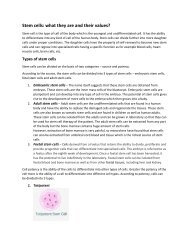Stem cells: what they are and their values?
These stem cells can treat diseases by regenerating themselves into daughter stem cells which further replace the damaged cells of the body to repair the tissues and organs.
These stem cells can treat diseases by regenerating themselves into daughter stem cells which further replace the damaged cells of the body to repair the tissues and organs.
You also want an ePaper? Increase the reach of your titles
YUMPU automatically turns print PDFs into web optimized ePapers that Google loves.
Cord lining<br />
The outermost layer of the umbilical cord is known as cord lining, umbilical cord lining <strong>and</strong> cord tissue.<br />
The umbilical cord itself is an extended part of the placenta <strong>and</strong> is a prolongation of the amniotic<br />
membrane which covers the placenta. The cord tissue membrane is made up of the amniotic layer<br />
which the epithelial layer <strong>and</strong> the sub-amniotic layer which is the epithelial layer. Umbilical cord tissue is<br />
the rich source of two types of stem <strong>cells</strong>, the epithelial stem <strong>cells</strong> <strong>and</strong> the mesenchymal stem <strong>cells</strong>.<br />
• Use of cord lining<br />
Mesenchymal stem <strong>cells</strong> have enormous potential to heal <strong>and</strong> cure different diseases in<br />
damaged tissues <strong>and</strong> organs. EpSC forms the soft tissue that binds, protects <strong>and</strong> covers the<br />
cornea, skin <strong>and</strong> liver of other body structures <strong>and</strong> organs. MSCs <strong>are</strong> the building blocks of bonecartilage,<br />
muscle, fibrous tissues <strong>and</strong> fat tissues in our body.<br />
• Diseases treated by stem <strong>cells</strong> harvested from cord lining<br />
The cord lining also contains stem <strong>cells</strong> as it is the rich source of mesenchymal stem <strong>cells</strong> (MSCs)<br />
<strong>and</strong> epithelial stem <strong>cells</strong> (EpSCs). These mesenchymal stem <strong>cells</strong> can help in treating diseases<br />
such as autism, multiple sclerosis, spinal cord injury <strong>and</strong> epithelial stem <strong>cells</strong> help in treating<br />
diseases related to skin, the cornea of the eye, etc.<br />
Cord blood collection method <strong>and</strong> storage<br />
Once your baby is born <strong>and</strong> separated, the umbilical cord is clamped <strong>and</strong> then the cord blood is<br />
collected in a single-use sterile 250mL blood bag. This cord blood along with cord tissue <strong>and</strong> mother’s<br />
blood sample is then kept in the Kit box which is transported to the storage laboratory by maintaining a<br />
controlled temperature. In the laboratory, the cord blood is processed by an advanced automated<br />
technology known as AXP®II for harvesting hematopoietic stem <strong>cells</strong>. These stem <strong>cells</strong> <strong>are</strong> then stored in<br />
compartmentalized cryopouches at -190°C in liquid nitrogen. This complete method of collection,<br />
processing <strong>and</strong> storage is known as cord blood banking.





